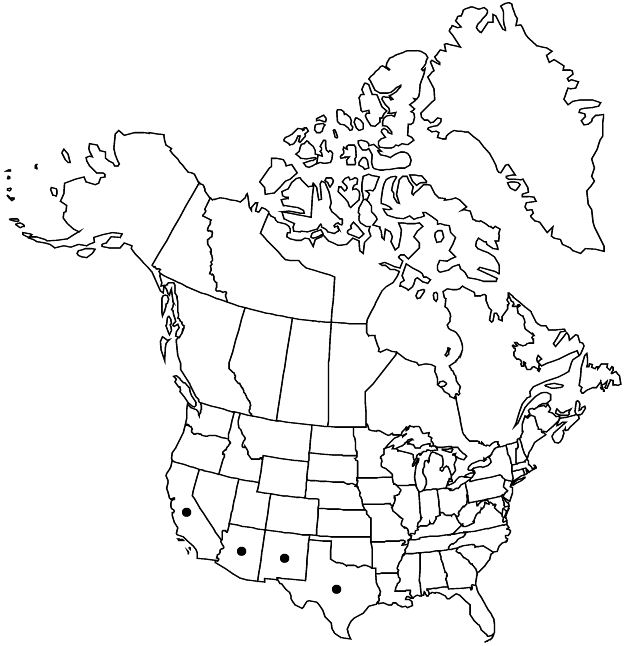Difference between revisions of "Euphorbia arizonica"
in W. H. Emory, Rep. U.S. Mex. Bound. 2(1): 186. 1859.
FNA>Volume Importer |
imported>Volume Importer |
||
| (3 intermediate revisions by 2 users not shown) | |||
| Line 1: | Line 1: | ||
{{Treatment/ID | {{Treatment/ID | ||
|accepted_name=Euphorbia arizonica | |accepted_name=Euphorbia arizonica | ||
| − | |accepted_authority=Engelmann | + | |accepted_authority=Engelmann |
|publications={{Treatment/Publication | |publications={{Treatment/Publication | ||
| − | |title=Rep. U.S. Mex. Bound. | + | |title=in W. H. Emory, Rep. U.S. Mex. Bound. |
|place=2(1): 186. 1859 | |place=2(1): 186. 1859 | ||
|year=1859 | |year=1859 | ||
| Line 12: | Line 12: | ||
|name=Chamaesyce arizonica | |name=Chamaesyce arizonica | ||
|authority=(Engelmann) Arthur | |authority=(Engelmann) Arthur | ||
| + | |rank=species | ||
}} | }} | ||
|hierarchy=Euphorbiaceae;Euphorbia;Euphorbia sect. Anisophyllum;Euphorbia arizonica | |hierarchy=Euphorbiaceae;Euphorbia;Euphorbia sect. Anisophyllum;Euphorbia arizonica | ||
| Line 36: | Line 37: | ||
-->{{#Taxon: | -->{{#Taxon: | ||
name=Euphorbia arizonica | name=Euphorbia arizonica | ||
| − | + | |authority=Engelmann | |
| − | |authority=Engelmann | ||
|rank=species | |rank=species | ||
|parent rank=section | |parent rank=section | ||
| Line 48: | Line 48: | ||
|distribution=Ariz.;Calif.;N.Mex.;Tex.;Mexico (Baja California;Baja California Sur;Chihuahua;Coahuila;Durango;Sonora). | |distribution=Ariz.;Calif.;N.Mex.;Tex.;Mexico (Baja California;Baja California Sur;Chihuahua;Coahuila;Durango;Sonora). | ||
|reference=None | |reference=None | ||
| − | |publication title=Rep. U.S. Mex. Bound. | + | |publication title=in W. H. Emory, Rep. U.S. Mex. Bound. |
|publication year=1859 | |publication year=1859 | ||
|special status= | |special status= | ||
| − | |source xml=https:// | + | |source xml=https://bitbucket.org/aafc-mbb/fna-data-curation/src/2e0870ddd59836b60bcf96646a41e87ea5a5943a/coarse_grained_fna_xml/V12/V12_28.xml |
|genus=Euphorbia | |genus=Euphorbia | ||
|section=Euphorbia sect. Anisophyllum | |section=Euphorbia sect. Anisophyllum | ||
Latest revision as of 20:14, 5 November 2020
Herbs, annual or short-lived perennial, with slender to slightly thickened taproot. Stems erect to ascending, 10–30 cm, uniformly pilose with glistening hairs. Leaves opposite; stipules distinct, deltate, (0–)0.1 mm, glabrous or with few scattered hairs; petiole 0.4–1.5 mm, pilose with glistening hairs; blade usually ovate, rarely elliptic, 3–11 × 2–7 mm, base asymmetric, one side cuneate to rounded, other side rounded to strongly cordate, margins entire, apex obtuse or acute, surfaces pilose with glistening hairs; 3-veined from base but usually only midvein conspicuous. Cyathia solitary at distal nodes; peduncle 0.7–3.6 mm. Involucre urceolate, 1.1–1.3 × 0.5–0.9 mm, glabrous or pilose with glistening hairs; glands 4, dark maroon, usually oblong to reniform, rarely almost circular, 0.2 × 0.2–0.4 mm; appendages white to pink, oblong, flabellate, oblong, or elliptic, 0.3–0.6 × 0.6–0.9 mm, distal margin entire or crenulate. Staminate flowers 5–12. Pistillate flowers: ovary pilose, styles 0.5–0.6 mm, 2-fid 1/2 length. Capsules broadly ovoid to subglobose, 1.4–1.8 mm diam., pilose; columella 1.1–1.4 mm. Seeds gray to light brown, ovoid, 4-angled in cross section, 0.9–1.1 × 0.5–0.6 mm, rugose with 2–5 irregular transverse ridges that sometimes pass through abaxial keel.
Phenology: Flowering and fruiting year-round in response to sufficient moisture.
Habitat: Washes and rocky slopes, sometimes on limestone, desert scrub communities often with creosote-bush, riparian forests, mesquite woodlands, oak chaparral.
Elevation: 100–1400 m.
Distribution

Ariz., Calif., N.Mex., Tex., Mexico (Baja California, Baja California Sur, Chihuahua, Coahuila, Durango, Sonora).
Discussion
Euphorbia arizonica is distinctive and easily recognized by its glistening, translucent hairs that appear somewhat glutinous and are most apparent on the stems.
Selected References
None.